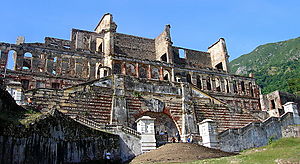Haití
Haití
Volunteer: the case of the Community Intervention Units in Haiti
Some special Haitians are volunteering to contribute to the development of their Country at local levels.
By Lara Palmisano
21 diciembre 2015 |
“Civil protection in Haiti works at different levels from national to local. After the earthquake of January 12, 2010, it recognized that it was crucial to build community level capacity to help the system as the closest and fastest connection with the community to spread alerts and act as first responders until more specialized aid could arrive, ’’ explained Ms. Mercedes Aguerre, DIPECHO project manager of COOPI for the DIPECHO project, in consortium with GOAL.
These volunteers accompany the municipal and local civil protection in the neighborhoods, and work with the other local actors in preparedness, mitigation and response activities. Their activities range from raising community awareness about threats and resources in the area, to practical and coordinated support to the beneficiaries in case of emergencies.
“With my team of 8 individuals, I raise awareness of more of 150 families; help them to be prepared to face an emergency, and actively help them in case of evacuation is needed. With an attentive heed to the community needs, we also support small scale infrastructure works, such as bridges to cross canals,” explained Mr. Jean Baptiste Robenson, EIC volunteer in the community of Carradeux (Tabarre). He also noted that; “The community needs our help. We are in a place cyclically threatened by storm and floods, with consequent related epidemics (i.e. cholera) and highly destructive impacts on people, buildings, land, water, and livestock. Thirty minutes of rain are enough to have heavy floods.”
On DRR funded projects in the urban area of Port au Prince and Tabarre, COOPI is improving the prevention and response skills of the vulnerable population through the strengthening of the EIC. Together, they also use tools such as the evacuation exercises and emergency family plans, to reinforce the capacity of the most vulnerable population to cope with emergency, explaining in a practical way how to be prepared.
“I am proud to volunteer for my community to help in such an important issue. And I do it because I care,” concluded Mr. Robenson.
Currently the national disaster risk management system, with the contribution of a number of different actors international organizations and international NGOs who have been instrumental in the creation of EICs, such as COOPI, are working on revising the methodology for creating and managing these structures. The EIC are daily proving in Haiti that is indeed possible to make an impact by mobilizing and engaging communities to change the world for a better future.
Good job, EIC! Be an inspiration to more and more people in the world.
COOPI’s website (www.coopi.org)
GOAL’s website (https://www.goalglobal.org/)
DIPECHO (http://ec.europa.eu/echo/what/humanitarian-aid/risk-reduction_en)


